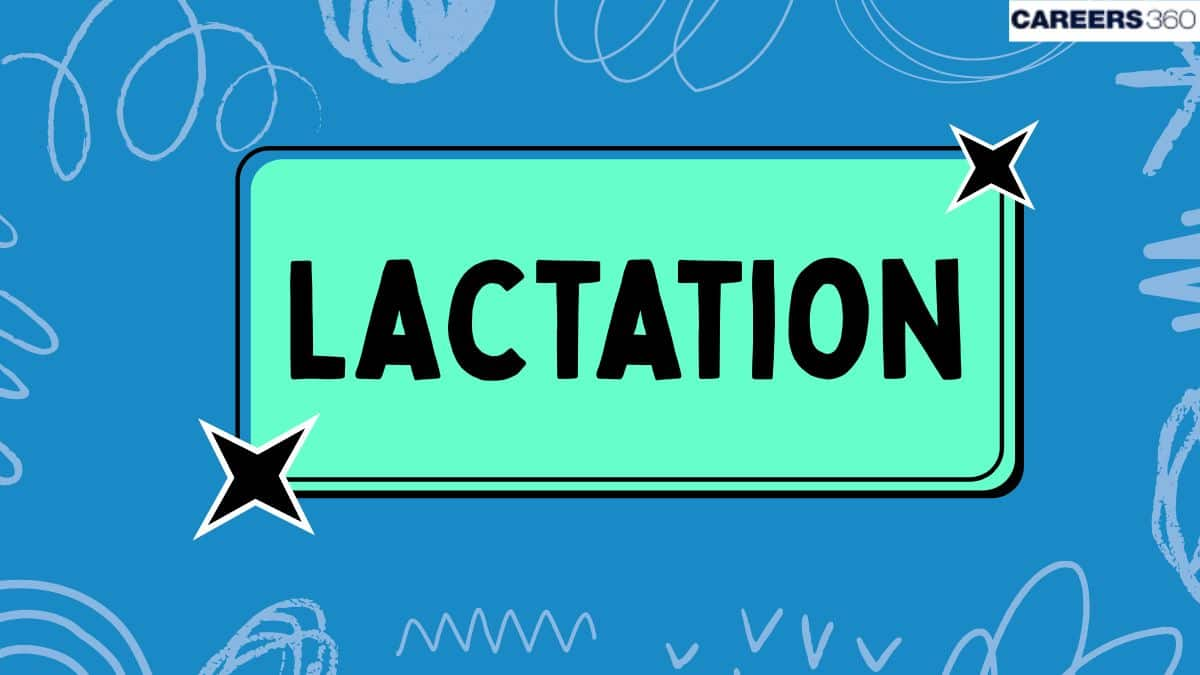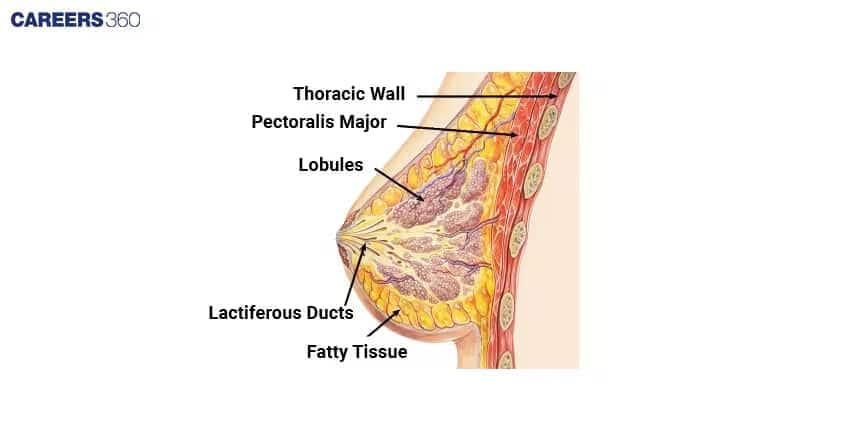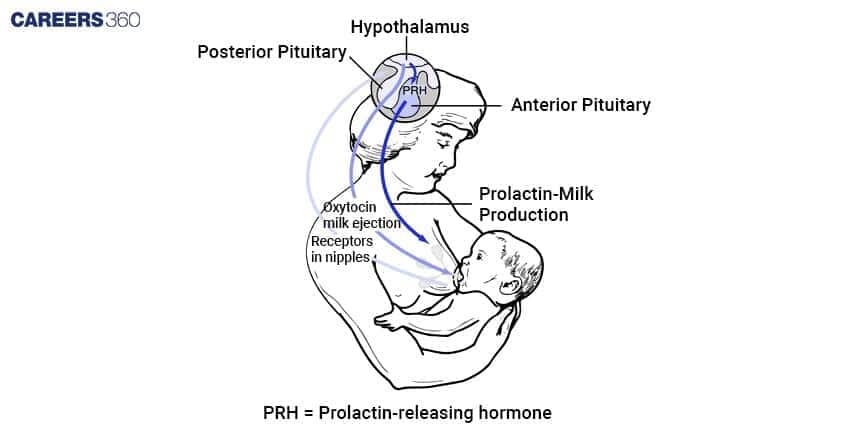Lactation: Definition, Lactation Process, Lactation Hormones
Lactation refers to the process by which milk is produced within the mother's body to feed the newborn. It is for the nourishment of her infant. It occurs after the delivery of a child and provides the baby with the necessary nutrients and antibodies for growth and health. Lactation is an important postnatal phase in Human Reproduction.
This Story also Contains
- What is Lactation?
- Lactation Preparation
- Lactation Process
- Hormones of Lactation
- Lactation Period
- Does Lactation Happen in the Absence of Pregnancy?
- Advantages of Breastfeeding
- Challenges of Lactation
- MCQs on Lactation
- Recommended video on Lactation

Understanding lactation helps learn how the human reproductive system supports both infant development and the mother's health. It is controlled by hormones like prolactin, oxytocin. Lactation begins soon after the parturition process. This article includes the Lactation Process, Hormones of Lactation, Lactation Period, and the advantages and Challenges of Lactation.
What is Lactation?
Lactation is the production and secretion of milk from the mammary glands of mammalia after parturition. Besides providing nutrition, lactation confers immunological protection to neonates owing to the presence of several antibodies in breast milk. The female reproductive system includes mammary glands that help in lactation after childbirth. The initiation of lactation is mainly due to hormonal changes during and at the end of pregnancy, particularly by the fall in progesterone and the increase in prolactin and oxytocin. Lactation is linked to reproductive health because it helps the mother feed her baby after delivery.
Lactation Preparation
Lactation preparation begins during pregnancy as the body gets ready to feed the baby. This natural process involves hormonal changes, breast development, and the early production of colostrum to support the newborn after birth.
Mammary glands in the body undergo severe changes during pregnancy in preparing for lactation.
At about the fifth or sixth month of pregnancy, the glands begin producing colostrum, a very nutritious fluid representing the first milk to which newborns are exposed.
Colostrum contains high amounts of immunoglobulin A, which is very crucial in the development of the newborn's immunity and immune system.

Lactation Process
The lactation process begins after childbirth when the mother's body starts producing milk. It is controlled by hormones like prolactin and oxytocin, which help make and release milk to feed the baby.
Lactation refers to milk secretion from the mammary glands.
Following parturition, the hormonal environment changes to permit an increase in milk production.
The stimulus to breastfeed, in turn, causes the release of oxytocin, which then causes the ejection of milk from the alveoli into the ducts where it is now available to the infant.
Mature milk contains the right proportions of all the nutrients that are needed by the child including fats, proteins and carbohydrates for healthy growth and development of the infant.

Hormones of Lactation
The process of lactation is controlled by hormones released from the pituitary gland and regulated by the hypothalamus. Several hormones have key roles in lactation:
Prolactin: This hormone triggers the production of milk in the alveoli.
Oxytocin: This hormone enables milk ejection reflex and enables milk to reach the nipple.
Estrogen and Progesterone: These are hormones that prepare the breasts to be able to lactate during pregnancy; however, they also inhibit milk production until delivery has occurred.
Lactation Period
It is the period when a mother starts producing milk for feeding her newborn. It sets in after childbirth since the hormonal changes at these periods mainly through prolactin and oxytocin stimulate milk production.
This period of lactation in humans varies widely due to personal choice and other cultural practices, from a few months to several years, although exclusive breastfeeding is often recommended until six months.
Does Lactation Happen in the Absence of Pregnancy?
Yes, this can also occur with lactation in non-pregnant individuals due to several reasons such as hormonal imbalance or even effects from some medications.
This may be from diseases like hyperprolactinemia, whereby too much prolactin is secreted thus stimulating milk production even when one is not pregnant.
Advantages of Breastfeeding
Some of the advantages of breastfeeding feeding both for the mother and the baby. It provides complete nutrition and strengthens the baby’s immune system, while also helping the mother recover and lowering her risk of some diseases.
In babies, it offers the best nutrition and enhances the immunity of the baby, which in turn diminishes the possibility of developing or catching any kind of infections, besides other serious chronic diseases.
In mothers, it makes one heal well after birth and reduces the risk of developing certain cancers like cancer in the breast and ovaries.
Challenges of Lactation
Even though breastfeeding is very advantageous, there exist several challenges that most mothers go through in breastfeeding, such as;
Poor supply of milk.
Very painful breastfeeding.
Social pressures/lack of support
Weaning and Cessation of Lactation
Weaning is the gradual withdrawal of the baby from breast milk toward solid foods.
This process may vary significantly across cultures and people. When milk demand decreases, lactation slows naturally.
Importance of Support for Lactating Women
The support a breastfeeding mother receives from the health care provider, family, and community goes a long way to a mother's success with this practice.
Much education regarding technique and troubleshooting often resolves many issues.
MCQs on Lactation
Question: Milk secretion in mammals is associated with
Vasopressin
Progesterone
Prolactin
Oxytocin
Answer: Lactation is the process by which mammary glands produce and secrete milk, starting at the end of the pregnancy. During gestation, hormones estrogen and progesterone, secreted by the corpus luteum or placenta, prepare the breasts for milk production. After delivery, when the level of progesterone decreases, prolactin release stimulates the formation of milk. Oxytocin releases the milk. Normally, lactation begins 1-3 days after delivery, enabling the mother to feed her newborn child.
Hence, the correct answer is Option (3) Prolactin.
Question: The milk produced initially is called
Casein
Colostrum
Lactose
All of them
Answer: Oxytocin plays a vital role in lactation by stimulating the release of milk from the mammary glands. Human milk is composed of water, organic, and inorganic substances, with its primary constituents being fats, casein, lactose, mineral salts, and vitamins. The milk produced during the initial days after childbirth is called colostrum, a nutrient-rich secretion that is especially high in IgA antibodies, which provide newborns with passive immunity and protect them against infections.
Hence, the correct option is 2) Colostrum.
Question: Given below are two statements: One is labelled as Assertion A and the other is labelled as Reason R:
Assertion A : Breast-feeding during initial period of infant growth is recommended by doctors for bringing a
healthy baby.
Reason R : Colostrum contains several antibodies absolutely essential to develop resistance for the new
born baby.
In the light of the above statements, choose the most appropriate answer from the options given below:
Both A and R are correct and R is the correct explanation of A
Both A and R are correct but R is NOT the correct explanation of A
A is correct but R is not correct
A is not correct but R is correct
Answer: Health professionals greatly recommend breastfeeding the infant to be fed on in the earliest period of child growth. After birth, babies produce colostrum-containing antibodies, an essential factor involved in the early development of immune systems. For the protection and general health care of infants before infections set off, early nutrition during the early time of a child's life is the most important starting point.
Hence, the correct answer is Option 1) Both A and R are correct and R is the correct explanation of A.
Recommended video on Lactation
Frequently Asked Questions (FAQs)
The World Health Organization recommends that babies be exclusively breastfed for up to six months, with continued breastfeeding along with appropriate complementary solid foods for up to two years or longer.
Almost all mothers can breastfeed. However, there are a few medical conditions and some medicines for which the mother needs to consult her health care provider first for safety both for herself and the baby.